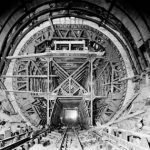silicosis
 Most safety measures have come from disasters caused by a lack of safety measures. The Hawk’s Nest Tunnel disaster was no different. But sometimes, the safety measures were known and readily available, but were not used, often to save time or money, and always in blatant disregard for the lives of the workers. On March 30, 1930, construction began on the Hawk’s Nest Tunnel. The tunnel was supposed to be a good thing, and in the end, it was, but the necessary measures were not used to keep the workers safe, and the time they spent in the tunnel turned out to be deadly.
Most safety measures have come from disasters caused by a lack of safety measures. The Hawk’s Nest Tunnel disaster was no different. But sometimes, the safety measures were known and readily available, but were not used, often to save time or money, and always in blatant disregard for the lives of the workers. On March 30, 1930, construction began on the Hawk’s Nest Tunnel. The tunnel was supposed to be a good thing, and in the end, it was, but the necessary measures were not used to keep the workers safe, and the time they spent in the tunnel turned out to be deadly.
This tunnel would be used to divert much of the flow of the New River from the Hawk’s Nest Dam under Gauley Mountain, located about 3 miles away, to a hydro-electric plant at the other end. As construction proceeded, it was discovered that the rock they were cutting had a high silica content. Silica was used in steel making. It seemed like a win-win situation, but  not for the 3,000 mostly African-American migrant workers from the south. Rhinehart and Dennis, a company from Charlottesville, Virginia, was awarded the contract. While the management, who visited the tunnel periodically, wore masks and breathing equipment, the workers were not given such equipment. Drilling should have been done using water, but it was not. They were trying to save time and money. The workers were exposed to the silica dust and developed a lung disease called silicosis, for which there is no cure.
not for the 3,000 mostly African-American migrant workers from the south. Rhinehart and Dennis, a company from Charlottesville, Virginia, was awarded the contract. While the management, who visited the tunnel periodically, wore masks and breathing equipment, the workers were not given such equipment. Drilling should have been done using water, but it was not. They were trying to save time and money. The workers were exposed to the silica dust and developed a lung disease called silicosis, for which there is no cure.
This deliberate disregard for safety caused some of the workers to become sick and die from silicosis within a year. There were only 109 admitted deaths, but a Congressional hearing conducted later determined that there were actually 476 deaths attributed to the project. Since that time, some sources have said the number could actually be as high as 700 to 1,000 deaths. This takes into account the workers that could have had minimal  exposure to the silica but were affected by it later in life.
exposure to the silica but were affected by it later in life.
The Hawk’s Nest Tunnel is still in use today, diverting water from the New River to produce hydro-electricity for the Alloy plant. Silicosis has been designated an occupational disease. Now compensation for workers affected by it is available. Unfortunately, the tunnel workers at Hawk’s Nest were not protected by these laws. This project is considered to be one of the worst industrial disasters in American history. The tunnel did its job, and continues to do so. I just wish it hadn’t cost so many lives to make the tunnel. It should not have had to come at such a great price.

